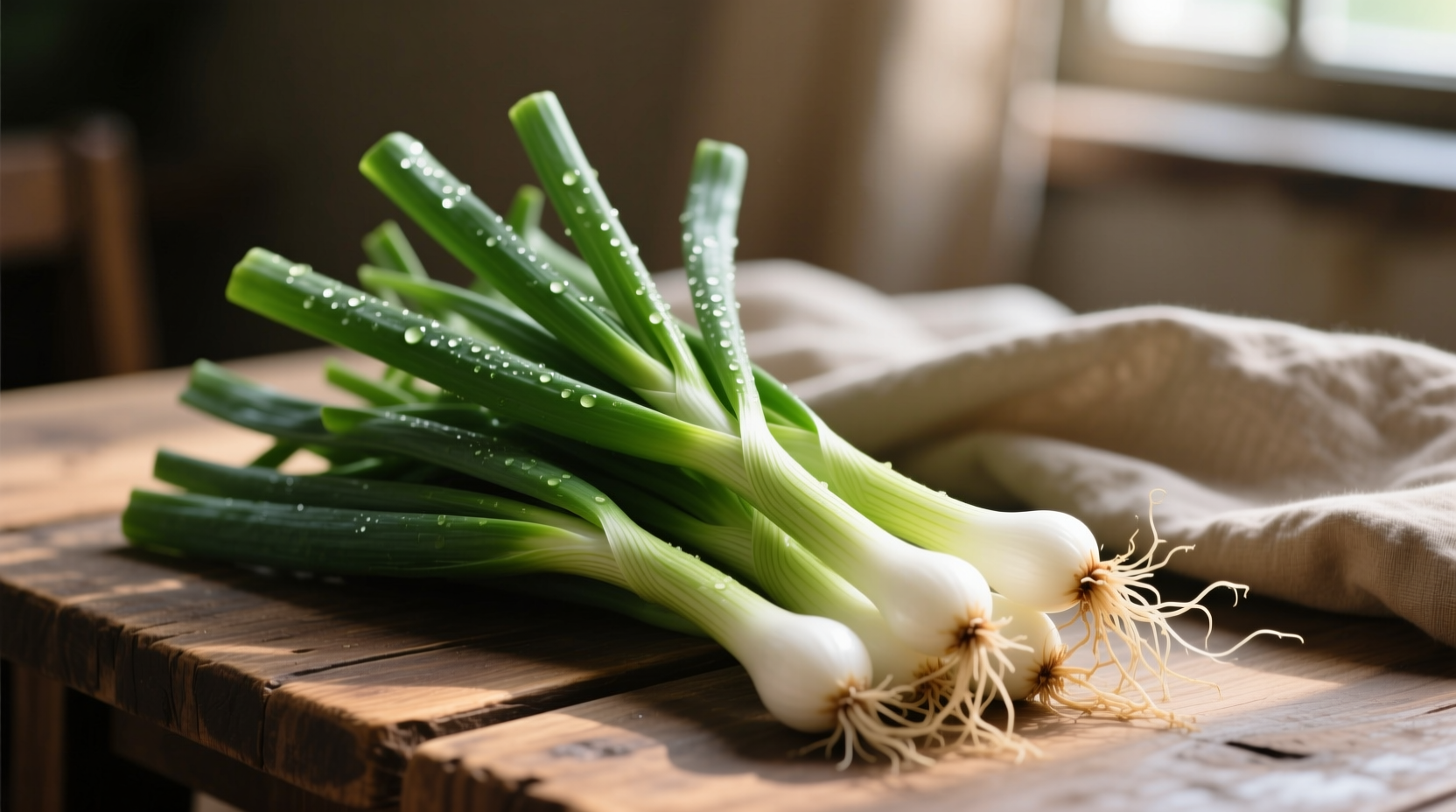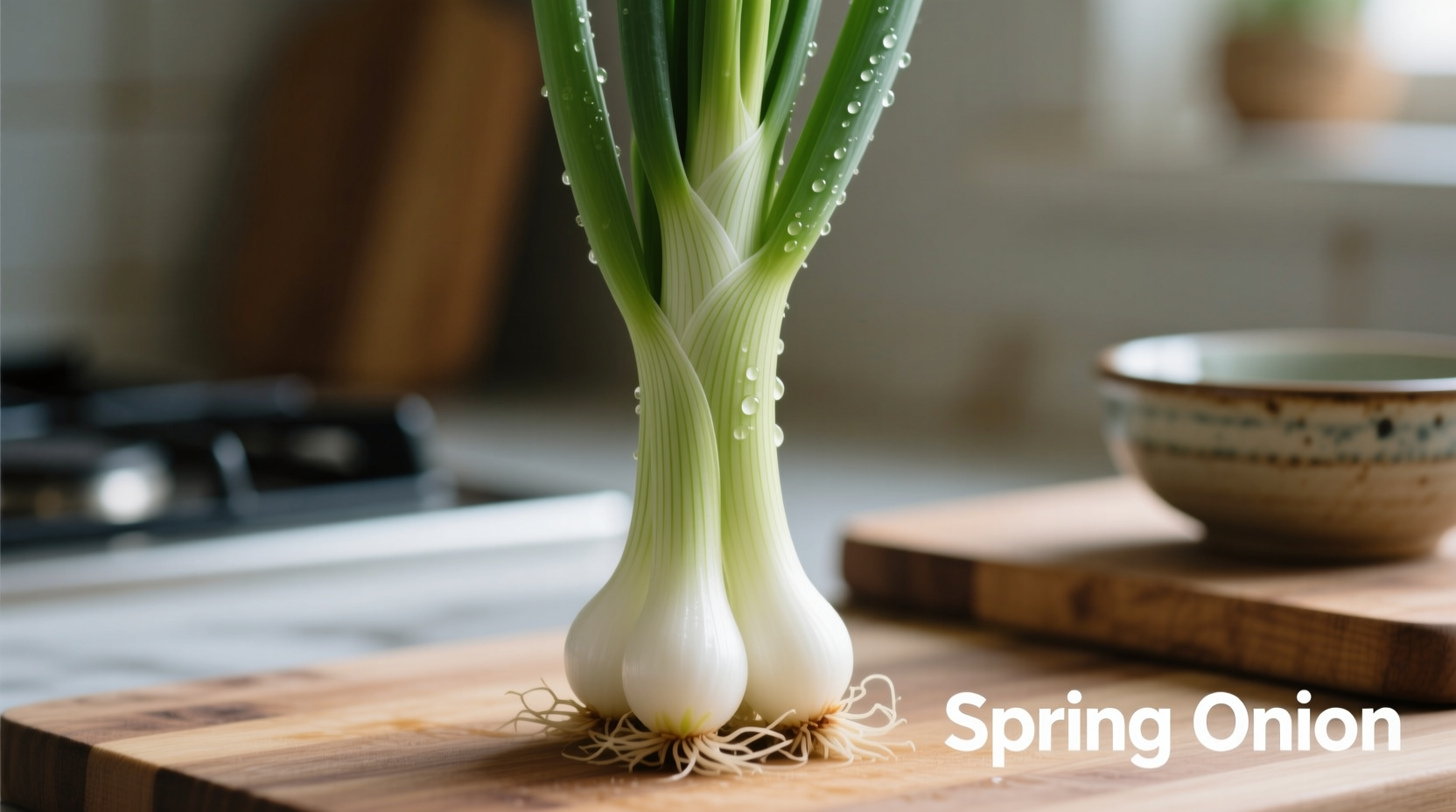Understanding exactly what spring onions are—and how they differ from similar alliums—can transform your cooking. Whether you're selecting them at the market or deciding how to use them in recipes, knowing their unique characteristics helps you make the most of this versatile ingredient.
How to Identify Spring Onions at a Glance
Spring onions have distinctive features that set them apart from other allium varieties. When shopping, look for these key characteristics:
- White bulb—smaller than a mature onion (typically 1-2 inches in diameter), often with thin, papery skin
- Long green stalks—hollow, cylindrical, and vibrant green from base to tip
- Root hairs—often still attached at the base when freshly harvested
- Mild aroma—less pungent than mature onions but stronger than chives

| Allium Type | Bulb Size | Flavor Profile | Best Culinary Uses |
|---|---|---|---|
| Spring Onion | Small (1-2 inches) | Mild, slightly sweet onion flavor | Raw in salads, grilled, stir-fries, garnishes |
| Scallion/Green Onion | Very small or no bulb | Delicate, grassy flavor | Garnishes, raw applications, light cooking |
| Chive | No bulb | Subtle onion-garlic notes | Finely chopped in sauces, potatoes, eggs |
| Mature Onion | Large (3+ inches) | Strong, pungent flavor | Caramelizing, soups, stews, long cooking |
Botanical Background and Seasonality
Botanically classified as Allium cepa var. aggregatum, spring onions are harvested approximately 60-80 days after planting, before the bulb fully matures. Unlike scallions (which come from Allium fistulosum and never develop a bulb), spring onions are essentially immature bulb onions.
According to agricultural data from the USDA National Agricultural Statistics Service, spring onions reach peak availability from March through June in most temperate climates, though greenhouse production makes them available year-round in many markets. Their seasonality explains the "spring" in their name, though they're commonly available beyond this season.
Culinary Characteristics and Applications
Spring onions offer a unique flavor profile that bridges the gap between raw onion sharpness and mild green onion subtlety. Their dual-texture composition provides culinary versatility:
- White bulb portion—crisp texture with concentrated flavor, ideal for quick cooking
- Green stalk portion—more delicate, grassy flavor perfect for raw applications
Professional chefs like those at the James Beard Foundation Cooking School recommend using spring onions in these ways:
- Raw applications: Thinly sliced in salads, salsas, or as a garnish for soups and tacos
- Quick cooking: Grilled whole, stir-fried, or roasted for 5-7 minutes to maintain texture
- Layered flavor building: Add white parts early in cooking for flavor base, green parts at the end for freshness
Selecting and Storing Spring Onions
Choosing high-quality spring onions ensures the best flavor and texture in your dishes. When selecting, look for:
- Firm, crisp stalks without yellowing or wilting
- Moist root ends (indicates freshness)
- Vibrant green color throughout the stalks
- No slimy spots or strong odors
For optimal storage, the University of California Cooperative Extension recommends:
- Refrigerate unwashed in a plastic bag with a paper towel to absorb moisture
- Store vertically in a glass of water (change water every 2 days)
- Use within 5-7 days for best quality
- Freeze chopped spring onions for cooked applications (though texture changes)
Common Cooking Mistakes to Avoid
Even experienced home cooks sometimes misuse spring onions. Based on culinary research from the Culinary Institute of America, these are the most frequent errors:
- Overcooking—their delicate texture turns mushy after 8-10 minutes of heat exposure
- Discarding green parts—both white and green portions are edible and offer different flavor profiles
- Using as direct substitute for mature onions—their milder flavor won't provide the same depth in long-cooked dishes
- Not washing properly—dirt often collects between the layers near the bulb
Global Culinary Applications
Spring onions appear in diverse cuisines worldwide, each culture utilizing them in distinctive ways:
- Asian cuisine: Essential in Chinese stir-fries and Vietnamese pho garnishes
- Mexican cooking: Grilled as accompaniment to tacos and grilled meats
- Middle Eastern dishes: Raw in salads like fattoush and as garnish for grilled meats
- European preparations: Pickled for charcuterie boards or in French potato salads
According to ethnobotanical research published in the Journal of Ethnobiology, spring onions have been cultivated for over 5,000 years, with early records showing their use in ancient Egyptian and Chinese agricultural systems.
Simple Preparation Techniques
Maximize your spring onion usage with these professional chef-recommended techniques:
- Cleaning: Trim root ends, slice off any browned top portions, then slice lengthwise from bulb to halfway up green stalk to release trapped dirt. Rinse under cold water while separating layers.
- Chopping for raw use: Slice crosswise into thin rounds (¼ inch), separating white and green parts if desired for different flavor intensities.
- Grilling: Toss whole spring onions with olive oil, salt, and pepper. Grill over medium heat for 3-4 minutes per side until charred but still crisp.
- Quick-pickling: Combine equal parts vinegar and water with 1 tablespoon sugar and 1 teaspoon salt. Pour over sliced spring onions and refrigerate for 30 minutes.
Frequently Asked Questions
Here are answers to common questions about spring onions:
Can I substitute scallions for spring onions in recipes?
Yes, scallions make a good substitute for spring onions in most recipes, though they have a milder flavor and lack the small bulb. Use a 1:1 ratio, but add a pinch of extra salt to compensate for the slightly less intense flavor. For cooked dishes requiring the bulb's texture, you may want to supplement with a small amount of regular onion.
Which parts of spring onions are edible?
Both the white bulb and green stalks of spring onions are completely edible. The white portion has a stronger onion flavor and holds up better to cooking, while the green portion is more delicate and best used raw or added at the end of cooking. Unlike mature onions, there's no need to discard any part except for the very root end and any wilted or discolored tips.
How do I know if spring onions have gone bad?
Spring onions have spoiled when they become slimy, develop dark spots, or emit a sour smell. Fresh spring onions should be crisp and firm. If the green tops have turned yellow or brown throughout (not just at the very tips), they're past their prime. Slightly wilted spring onions can often be revived by placing them in ice water for 15-20 minutes.
Why are they called spring onions if available year-round?
They're called spring onions because they naturally reach peak harvest season in spring when grown outdoors in temperate climates. While greenhouse production and global shipping now make them available year-round, the name reflects their traditional seasonal availability. In some regions with year-round growing seasons, they're sometimes called "salad onions" to avoid seasonal confusion.
Can I grow spring onions at home?
Yes, spring onions are one of the easiest vegetables to grow at home. Plant onion sets or seeds in well-drained soil with full sun exposure. Harvest when the bulbs reach 1-2 inches in diameter, typically 60-80 days after planting. You can even regrow spring onions from kitchen scraps by placing the root end in water on a windowsill, though the regrown version will be smaller and less robust than store-bought.











 浙公网安备
33010002000092号
浙公网安备
33010002000092号 浙B2-20120091-4
浙B2-20120091-4